Coldstream Guards
The Coldstream Guards (COLDM GDS) is a part of the Guards Division,[2] Foot Guards regiments of the British Army. It is the oldest regiment in the British Army in continuous active service,[3] originating in Coldstream, Scotland, in 1650 when General George Monck founded the regiment.
| The Coldstream Guards | |
|---|---|
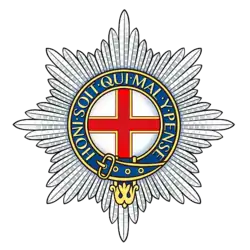 Regimental badge of the Coldstream Guards | |
| Active | 1650–present |
| Country | (1660–1707) (1801–present) |
| Branch | |
| Type | Infantry |
| Role | 1st Battalion – Light Mechanised No 7 Company – Public Duties |
| Size | One battalion – 559 personnel[1] One incremental (independent) company |
| Part of | Guards Division |
| Garrison/HQ | RHQ – London 1st Battalion—Windsor No.7 Company—London |
| Nickname(s) | The Lilywhites |
| Motto(s) | "Nulli Secundus" (Latin) "Second to None" |
| March | Quick – Milanollo Slow – Figaro ("Non più andrai" from The Marriage of Figaro) |
| Anniversaries | St George's Day (23 April) |
| Engagements | English Civil War Monmouth Rebellion War of the Spanish Succession War of the Austrian Succession Seven Years' War American War of Independence Napoleonic Wars Crimean War Second Boer War The Great War Second World War Malayan Emergency Mau Mau Uprising Cyprus Emergency Gulf War Bosnia Iraq War Operation Herrick |
| Commanders | |
| Colonel in Chief | The Queen |
| Colonel of the Regiment | Lieutenant General Sir James Bucknall, KCB, CBE |
| Insignia | |
| Tactical Recognition Flash |  |
| Plume | Red Right side of Bearskin cap |
| Abbreviation | COLDM GDS |
History
English Civil War
The origin of The Coldstream Guards lies in the English Civil War when Oliver Cromwell gave Colonel George Monck permission to form his own regiment as part of the New Model Army. Monck took men from the regiments of George Fenwick and Sir Arthur Haselrig, five companies each, and on 13 August 1650 formed Monck's Regiment of Foot.[4] Less than two weeks later, this force took part in the Battle of Dunbar, at which the Roundheads defeated the forces of Charles Stuart.[4]
After Richard Cromwell's abdication, Monck gave his support to the Stuarts, and on 1 January 1660 he crossed the River Tweed into England at the village of Coldstream, from where he made a five-week march to London. He arrived in London on 2 February and helped in the Restoration of the monarchy. For his help, Monck was given the Order of the Garter and his regiment was assigned to keep order in London. However, the new parliament soon ordered his regiment to be disbanded with the other regiments of the New Model Army.[4]
Before that could happen, Parliament was forced to rely on the help of the regiment against the rebellion by the Fifth Monarchists led by Thomas Venner on 6 January 1661. The regiment defeated the rebels and on 14 February the men of the regiment symbolically laid down their arms as part of the New Model Army and were immediately ordered to take them up again as a royal regiment of The Lord General's Regiment of Foot Guards, a part of the Household Troops.[5]
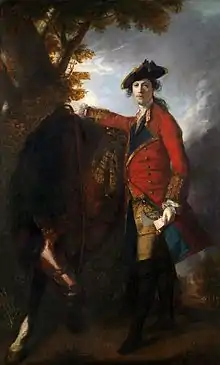
The regiment was placed as the second senior regiment of Household Troops, as it entered the service of the Crown after the 1st Regiment of Foot Guards, but it answered to that by adopting the motto Nulli Secundus (Second to None) as the regiment is older than the senior regiment. The regiment always stands on the left of the line when on parade with the rest of the Foot Guards, so standing "second to none". When Monck died in 1670, the Earl of Craven took command of the regiment and it adopted a new name, the Coldstream Regiment of Foot Guards.[4]
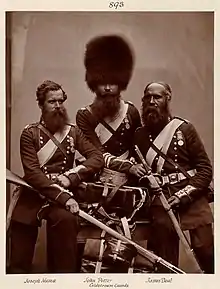
Overseas service (1685-1900)
The regiment saw active service in Flanders and in the Monmouth Rebellion, including the decisive Battle of Sedgemoor in 1685. It fought in the Battle of Walcourt in 1689, the Battle of Landen and the Siege of Namur.[4]
In 1760, the 2nd Battalion was sent to Germany to campaign under Prince Ferdinand of Brunswick and fought in the Battle of Wilhelmstal and at the Castle of Amöneburg. Three Guards companies of 307 men under Coldstream commander Colonel Edward Mathew fought in the American Revolutionary War.[4]
The Coldstream Regiment saw extensive service in the wars against the French Revolution and in the Napoleonic Wars. Under the command of Sir Ralph Abercrombie, it defeated French troops in Egypt. In 1807, it took part in the investment of Copenhagen. In January 1809, it sailed to Portugal to join the forces under Sir Arthur Wellesley. In 1814, it took part in the Battle of Bayonne, in France, where a cemetery keeps their memory. The 2nd Battalion joined the Walcheren Expedition. Later, it served as part of the 2nd Guards Brigade in the chateau of Hougoumont on the outskirts of the Battle of Waterloo. This defence is considered one of the greatest achievements of the regiment, and an annual ceremony of "Hanging the Brick" is performed each year in the Sergeants' Mess to commemorate the efforts of Cpl James Graham and Lt-Col James Macdonnell, who shut the North Gate after a French attack.[6] The Duke of Wellington himself declared after the battle that "the success of the battle turned upon closing the gates at Hougoumont".[7]
The regiment was later part of the British occupation forces of Paris until 1816.[4]
During the Crimean War, the Coldstream Regiment fought in the battles of Alma, Inkerman and Sevastopol. On its return, four men of the regiment were awarded the newly instituted Victoria Cross.[4]
The regiment received its current name, The Coldstream Guards, in 1855. In 1882, it was sent to Egypt against the rebels of Ahmed 'Urabi and in 1885 in the Suakin Campaign. In 1897, the Coldstreamers were reinforced with the addition of a 3rd battalion. The 1st and 2nd battalions were dispatched to South Africa at the outbreak of the Second Boer War.[4]
1900–present
At the outbreak of the First World War, the Coldstream Guards was among the first British regiments to arrive in France after Britain declared war on Germany. In the following battles, it suffered heavy losses, in two cases losing all of its officers. At the First Battle of Ypres, the 1st battalion was virtually annihilated: by 1 November down to 150 men and the Lt Quartermaster. The regiment fought at Mons, Loos, the Somme, Ginchy and in the 3rd Battle of Ypres. The regiment also formed the 4th (Pioneer) Battalion, which was disbanded after the war, in 1919. The 5th Reserve battalion never left Britain before it was disbanded.[4]
When the Second World War began, the 1st and 2nd battalions of The Coldstream Guards were part of the British Expeditionary Force (BEF) in France;[4] whilst the 3rd Battalion was on overseas service in the Middle East. Additional 4th and 5th battalions were also formed for the duration of the war. They fought extensively, as part of the Guards Armoured Division, in North Africa and Europe as dismounted infantry. The 4th battalion first became a motorized battalion in 1940 and then an armoured battalion in 1943.[8]
Coldstreamers gave up their tanks at the end of the war, the new battalions were disbanded, and the troops distributed to the 1st and 2nd Guard Training Battalions.[4]

After the war, the 1st and 3rd battalions served in Palestine. The 2nd battalion served in the Malayan Emergency. The 3rd battalion was placed in suspended animation in 1959. The remaining battalions served during the Mau Mau rebellion from 1959 to 1962, in Aden in 1964, in Mauritius in 1965, in the Turkish invasion of Cyprus in 1974 and several times in Northern Ireland after 1969.[4]
The Regimental Band of The Coldstream Guards was the first act on stage at the Wembley leg of the 1985 Live Aid charity concert. It played for the Prince and Princess of Wales.[9]
In 1991, the 1st battalion was dispatched to the first Gulf War, where it was involved in prisoner of war handling and other roles. In 1993, due to defence cutbacks, the 2nd battalion was placed in suspended animation.[4]
For much of the 1990s, the 1st Battalion was stationed in Münster, Germany, in the Armoured Infantry Role with Warrior APCs as part of the 4th Armoured Brigade. In 1993–1994, the battalion served as an armoured infantry battalion in peacekeeping duties in Bosnia as part of UNPROFOR.[4]
The battalion was posted to Londonderry, Northern Ireland on a two-year deployment in 2001. It then deployed to Iraq in April 2005 for a six-month tour with the rest of 12th Mechanised Brigade, based in the south of the country. The battalion lost two of its soldiers, on 2 May, near Al Amarah and on 18 October at Basra.[10]
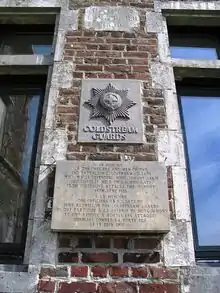
Des Browne, Secretary of State for Defence, announced on 19 July 2007 that in October 2007 the battalion was to be sent to Afghanistan as part of 52 Infantry Brigade. In March 2008, while on patrol with the ANA, members of the Regiment discovered a Taliban torture chamber.[11]
In October 2009, the battalion was deployed on Operation Herrick 11, with units deploying to the Babaji area of central Helmand Province, Afghanistan, playing a major role in Operation Moshtarak in February 2010.[12]
Before the Strategic Defence and Security Review 2010 the battalion was part of the 12th Mechanised Brigade in a light infantry role. Under Army 2020 it transferred to London District as a public duties battalion, then in 2019 it joined the 11th Infantry Brigade and Headquarters South East.[13][14][15]
Structure
The structure of the regiment and affiliated band includes:
- Regimental Headquarters, at Wellington Barracks, London[16][17][18]
- 1st Battalion, at Victoria Barracks, Windsor (Light Infantry part of 11th Infantry Brigade and Headquarters South East)[19][20][21][22][23][24]
- Battalion Headquarters[21]
- Headquarters Company[21]
- No.1 Company (Senior Company)[21]
- No.2 Company[21]
- No.3 Company[21]
- Support (No.4) Company (includes regimental corps of drums)[13][20][21]
- No.7 Company, based at Wellington Barracks, London (maintaining the traditions and colours of the old 2nd Battalion placed in S/A in 1993)[18][20][25][26]
- Band of the Coldstream Guards, based at Wellington Barracks, London (part of the CAMUS)[18][19][20][27][28]
Role

Companies that make up the regiment are traditionally numbered. New officers destined for the regiment that are at Sandhurst or at the Infantry Battle School form No. 13 Coy, while Guardsmen under training at ITC Catterick make up No. 14 Coy.[29] No. 7 Coy is one of the incremental companies formed to undertake public duties in London and Windsor, and maintains the colours and traditions of the former 2nd Battalion.[30] Currently, the most prominent role of the 1st Battalion and No. 7 Company is the performance of ceremonial duties in London and Windsor as part of the Household Division. Operationally, The Coldstream Guards currently perform the role of light infantry. The 1st Battalion is based in Windsor at Victoria Barracks as an operational light infantry battalion.[30]

The Corps of Drums, in addition to their ceremonial role, which has been primarily the musical accompaniment of Changing of the Guard for Windsor Castle, has the role of machine gun platoon. All Guardsmen for public duties wear the 'Home Service' Dress tunic in summer or greatcoat in winter and bearskin with a red plume. The Coldstream Guards regimental band plays at Changing of The Guard, state visits and many other events.[30]
Unlike the other four regiments of foot guards, which recruit from each of the four home nations, the Coldstream Guards has a specific recruiting area, which encompasses the counties that Monck's Regiment passed through on its march from Coldstream to London. The traditional recruiting area of the Coldstream Guards is the South West and North East of England.[30]
The Coldstream Guards and other Guards Regiments have a long-standing connection to The Parachute Regiment. Guardsmen who have completed P company have the option of being posted to the Guards Parachute Platoon, 3 PARA, still keeping the tradition of the No 1 (Guards) Independent Parachute Company, which was the original Pathfinder Group of 16th Parachute Brigade, now renamed 16th Air Assault Brigade.[31]
Traditions

The grouping of buttons on the tunic is a common way to distinguish between the regiments of Foot Guards. Coldstream buttons are arranged in pairs, and a Star of the Garter is marked on their brassware.[32]
The regiment is ranked second in the order of precedence, behind The Grenadier Guards. The regiment have the motto Nulli Secundus (Second to None), which is a play on the fact that the regiment was originally the "Second Regiment of Foot Guards".[33]
The regiment's nickname is Lilywhites. An ordinary soldier of the regiment is called a Guardsman, a designation granted by King George V after the First World War. The regiment is always referred to as the Coldstream, never as the Coldstreams; likewise, a member of the regiment is referred to as a Coldstreamer.[32]
Training
Recruits to the Guards Division go through an intensive training programme at the British Army's Infantry Training Centre (ITC). Their training is two weeks longer than the programme provided for recruits to the Regular line infantry regiments of the British Army; the extra training, carried out throughout the course, is devoted to drill and ceremonies.[34]
Regimental Colonels
- George Monck's Regiment (1650)
- Lord General's Regiment of Foot Guards (1661)
- Captain-General George Monck, 1st Duke of Albemarle, 1650–1678[35]
- Coldstream Regiment of Foot Guards (1670)
- Lieutenant General William Craven, 1st Earl of Craven, 1678–1689[35]
- Lieutenant General Thomas Talmash (or Tollemache), 1689–1694[35]
- Lieutenant General John Cutts, 1st Baron Cutts, 1694–1702[35]
- General Charles Churchill, 1702–1714[35]
- Lieutenant General William Cadogan, 1st Earl of Cadogan, 1714–1722[35]
- Colonel Richard Lumley, 2nd Earl of Scarbrough, 1722–1740[36]
- Field Marshal Prince William, Duke of Cumberland, 1740–1742[36]
- Colonel Charles Spencer, 3rd Duke of Marlborough, 1742–1744[36]
- Lieutenant General Willem Anne van Keppel, 2nd Earl of Albemarle, 1744–1755[36]
- Lieutenant General James O'Hara, 2nd Baron Tyrawley, 1755–1773[36]
- General John Waldegrave, 3rd Earl of Waldegrave, 1773–1784[36]
- Field Marshal Prince Frederick, Duke of York and Albany, 1784–1805[36]
- Field Marshal Prince Adolphus, Duke of Cambridge, 1805–1850[36]
- Field Marshal John Byng, 1st Earl of Strafford, 1850–1860[36]
- Coldstream Guards (1855)
- Field Marshal Colin (Macliver) Campbell, 1st Baron Clyde, 1860–1863[36]
- Field Marshal Sir William Maynard Gomm, 1863–1875[36]
- General Sir William John Codrington, 1875–1884[36]
- General Sir Thomas Montagu Steele, 1884–1890[36]
- General Sir Arthur Edward Hardinge, 1890–1892[36]
- General Sir Frederick Stephenson, 1892–1911[36]
- General Lord William Frederick Ernest Seymour, 1911–1915[37]
- Major General Evelyn Edward Thomas Boscawen, 7th Viscount Falmouth, 1915–1918[38]
- Lieutenant General Sir Alfred Edward Codrington, 1918–1945[39]
- General Sir Charles Loyd, 1945–1962[40]
- General Sir Walter Arthur George Burns, 1962–1994[41]
- Lieutenant General Sir William Edward Rous, 1994–1999[42]
- General Sir Hugh Michael Rose, 1999–2009[43]
- Lieutenant General Sir James Jeffrey Corfield Bucknall, 2009–present[44]
Battle honours
The Coldstream Guards have earned 117 battle honours:[45][46]
- Tangier 1680, Namur 1695, Gibraltar 1704–1705, Oudenarde, Malplaquet, Dettingen, Lincelles, Egypt, Talavera, Barrosa, Fuentes d'Onor, Salamanca, Nive, Peninsula, Waterloo, Alma, Inkerman, Sevastopol, Tel-el-Kebir, Egypt 1882, Suakin 1885, Modder River, South Africa 1899–1902
- The Great War (5 battalions): Mons, Retreat from Mons, Marne 1914, Aisne 1914, Ypres 1914 '17, Langemarck 1914, Gheluvelt, Nonne Bosschen, Givenchy 1914, Neuve Chapelle, Aubers, Festubert 1915, Loos, Mount Sorrel, Somme 1916 '18, Flers-Courcelette, Morval, Pilckem, Menin Road, Poelcappelle, Passchendaele, Cambrai 1917 '18, St. Quentin, Bapaume 1918, Arras 1918, Lys, Hazebrouck, Albert 1918, Scarpe 1918, Drocourt-Quéant, Hindenburg Line, Havrincourt, Canal du Nord, Selle, Sambre, France and Flanders 1914–1918
- The Second World War: Dyle, Defence of Escaut, Dunkirk 1940, Cagny, Mont Pincon, Quarry Hill, Estry, Heppen, Nederrijn, Venraij, Meijel, Roer, Rhineland, Reichswald, Cleve, Goch, Moyland, Hochwald, Rhine, Lingen, Uelzen, North-West Europe 1940 '44–45, Egyptian Frontier 1940, Sidi Barrani, Halfaya 1941, Tobruk 1941–42, Msus, Knightsbridge, Defence of Alamein Line, Medenine, Mareth, Longstop Hill 1942, Sbiba, Steamroller Farm, Tunis, Hammam Lif, North Africa 1940–1943, Salerno, Battipaglia, Capezzano, Volturno Crossing, Monte Camino, Calabritto, Garigliano Crossing, Monte Ornito, Monte Piccolo, Capture of Perugia, Arezzo, Advance to Florence, Monte Domini, Catarelto Ridge, Argenta Gap, Italy 1943–1945
- Gulf 1991[47]
Order of precedence
| Preceded by Grenadier Guards |
Infantry Order of Precedence | Succeeded by Scots Guards |
Alliances
Gallery
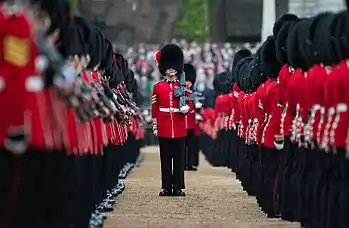 A Coldstream Guards Sergeant dressing through the ranks during the rehearsal for the Trooping the Colour
A Coldstream Guards Sergeant dressing through the ranks during the rehearsal for the Trooping the Colour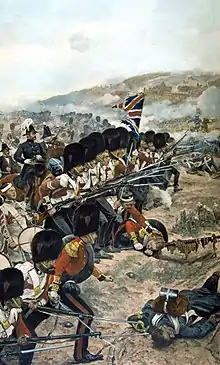 Battle of Alma in the Crimean War
Battle of Alma in the Crimean War
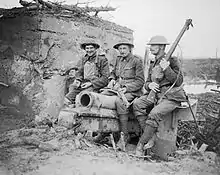 4th Coldstream in the Third Battle of Ypres, 1917
4th Coldstream in the Third Battle of Ypres, 1917 Coldstream Guard members of the Guards Parachute Platoon
Coldstream Guard members of the Guards Parachute Platoon Guardsman using the Sharpshooter Weapon System
Guardsman using the Sharpshooter Weapon System Section Second in Command giving Quick Battle Orders during exercise
Section Second in Command giving Quick Battle Orders during exercise 81mm Mortar moments after firing.
81mm Mortar moments after firing..jpg.webp) U.S. President Donald Trump and Queen Elizabeth II, accompanied by Major Oliver Biggs, reviewing the 1st Battalion, Coldstream Guards at Windsor Castle during Trump's visit to London in July 2018.
U.S. President Donald Trump and Queen Elizabeth II, accompanied by Major Oliver Biggs, reviewing the 1st Battalion, Coldstream Guards at Windsor Castle during Trump's visit to London in July 2018. Battle of Bayonne's cemetery, 1814, France, detail
Battle of Bayonne's cemetery, 1814, France, detail
See also
- Category:Coldstream Guards officers
- Category:Coldstream Guards soldiers
- Eddie Chapman criminal and World War II British double agent served with the Coldstream Guards.
- Honourable Artillery Company, the oldest surviving regiment in the British Army
- Band of the Coldstream Guards
Notes
- "Army – Question for Ministry of Defence". p. 1. Retrieved 14 December 2020.
- "Coldstream Guards – British Army Website". Army.mod.uk. Retrieved 10 April 2013.
- "Coldstream guards: history". Ministry of Defence. Retrieved 19 July 2014.
- "History of the Coldstream Guards". Archived from the original on 6 September 2013. Retrieved 26 April 2014.
- Harwood 2006, p. 38.
- "Coldstream Guards: Waterloo". Shinycapstar.com. Archived from the original on 9 July 2009. Retrieved 3 September 2009.
- Roberts, p 58
- ""Cuckoo" the German Panther in Service with the 4th Battalion Coldstream Guards". BBC. Retrieved 26 April 2014.
- "Live Aid Introduction: Prince & Princess Royal Salute". Retrieved 26 April 2014.
- "Sergeant Chris Hickey of 1st Battalion the Coldstream Guards killed in Iraq". Ministry of Defence. 20 October 2005. Retrieved 26 April 2014.
- "Coldstream Guards find torture chamber". Ministry of Defence. 11 March 2008. Archived from the original on 11 March 2008. Retrieved 26 April 2014.
- "Lieutenant Douglas Dalzell killed in Afghanistan". Ministry of Defence. 18 February 2010. Retrieved 26 April 2014.
- "Trooping the Colour 2000 (The Preamble)". Youtube. 8 April 2019. Retrieved 19 July 2020.
- "1st Bn, Coldstream Guards: Service". 16 December 2007. Archived from the original on 16 December 2007. Retrieved 20 July 2020.
- "12 Mechanized Brigade – British Army Website". 17 April 2009. Archived from the original on 17 April 2009. Retrieved 20 July 2020.
- "Coldstream Guards [UK]". 20 December 2007. Archived from the original on 20 December 2007. Retrieved 20 July 2020.
- "Regimental Headquarters". Coldstream Guards. Retrieved 20 July 2020.
- "Number 7 Company". Coldstream Guards. Retrieved 20 July 2020.
- "Coldstream Guards". www.army.mod.uk. Retrieved 20 July 2020.
- "Trooping the Colour 2016". Youtube. 17 June 2016. Retrieved 19 July 2020.
- "1st Battalion". Coldstream Guards. Retrieved 20 July 2020.
- "Regular Army Basing Matrix by Formation and Unit" (PDF). Army Families Federation. Archived from the original (PDF) on 14 August 2016. Retrieved 15 July 2020.
- "Order of Battle, Manpower, and Basing Locations". parliament.uk. Retrieved 15 July 2020.
- "British Army units from 1945 on – Coldstream Guards". british-army-units1945on.co.uk. Retrieved 20 July 2020.
- "Ceremonial duties – British Army Website". 10 November 2014. Archived from the original on 10 November 2014. Retrieved 20 July 2020.
- "Coldstream Guards – British Army Website". 7 January 2015. Archived from the original on 7 January 2015. Retrieved 20 July 2020.
- "Contact us – British Army Website". 23 January 2015. Archived from the original on 23 January 2015. Retrieved 20 July 2020.
- "Coldstream Guards Band". Coldstream Guards. Retrieved 20 July 2020.
- "Guards Infantry Training Battalion". Archived from the original on 26 April 2014. Retrieved 26 April 2014.
- "Coldstream Guards". Ministry of Defence. Retrieved 26 April 2014.
- "No 1 (Guards) Independent Parachute Company". ParaData. Archived from the original on 21 July 2015. Retrieved 10 April 2013.
- "Ceremonial duties". Ministry of Defence. Retrieved 26 April 2014.
- "British History Online". India.british-history.ac.uk. Retrieved 10 April 2013.
- "Combat Infantryman's Course – Foot Guards". Ministry of Defence. Retrieved 27 April 2014.
- Ross of Bladensburg, Lt. Col. Sir John Foster George. A History of the Coldstream Guards, from 1815–1895. London: A.D. Innes & Co., 1896. p. 478
- Ross of Bladensburg, Lt. Col. Sir John Foster George. A History of the Coldstream Guards, from 1815–1895. London: A.D. Innes & Co., 1896. p. 479
- National Portrait Gallery
- "Evelyn Edward Thomas Boscawen". Cricket Archive. Retrieved 28 April 2014.(subscription required)
- "CODRINGTON, Lieut-Gen. Sir Alfred Edward ". (2008). In Who Was Who 1897–2007. Online edition.
- Smart, Nick (2005). Biographical Dictionary of British Generals of the Second World War. Barnesley: Pen & Sword. p. 196. ISBN 1844150496.
- "North Mymms on the Home Front". Retrieved 9 October 2007.
- "No. 53587". The London Gazette (Supplement). 15 February 1994. p. 2316.
- "No. 55609". The London Gazette. 14 September 1999. p. 9833.
- "No. 59223". The London Gazette (Supplement). 27 October 2009. p. 18435.
- "Queen presents new Colours to Coldstream Guards". Ministry of Defence. 3 May 2012. Retrieved 26 April 2014.
- "Coldstream Guards". Regiments.org. Archived from the original on 8 February 2006. Retrieved 10 August 2019.
- "Gulf battle honours". The Independent. 20 October 2003.
- "Navy News, Ship of the Month May 1999". Archived from the original on 25 March 2008. Retrieved 14 March 2008.
Affiliations: City of Sunderland; Coldstream Guards; 30 Squadron RAF; The Worshipful Company of Farriers; Pangbourne College; Brymon Airways; Old Ocean Association
References
- Sir Julian Paget, Bt – Second to none : the Coldstream Guards, 1650–2000 (2000) ISBN 0-85052-769-4
- Harwood, Brian (2006). Chivalry and Command: 500 Years of Horse Guards (illustrated, annotated ed.). Osprey Publishing. p. 38. ISBN 1-84603-109-5.
- Roberts, Andrew; Waterloo: Napoleon's Last Gamble, 2005, London: HarperCollins Publishers, ISBN 0-00-719075-1
Further reading
- . Encyclopædia Britannica. 12 (11th ed.). 1911. pp. 656–659. — see end of page 657 and the start of 568
External links
| Wikimedia Commons has media related to Coldstream Guards. |
- Official website
- The Guards Museum Containing the history of the five regiments of Foot Guards, Wellington Barracks, London.
- Coldstream Guards (Official Site)
- Coldstream Guards Band site
- The Queen's Footguards
- Shiny Capstar (unofficial site)
- Canadian Coldstream Guards
- Coldstream Guards Corps Of Drums
- "Milanollo – Quick March of the Coldstream Guards" on YouTube
- Behind the Scenes with The Coldstream Guards Soldiery Portrait Exhibition on YouTube
- The Coldstream Guards Association Windsor Branch No.18
- British Army Locations from 1945 British Army Locations from 1945
- Origin and services of the Coldstream guards Colonel Daniel Mackinnon